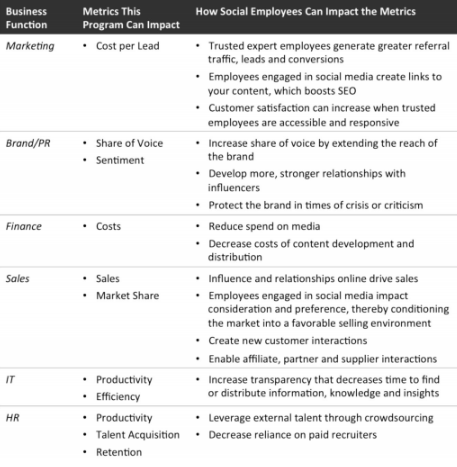To establish an employee social engagement program, you’ll need to build a business case that explains the value the program will create as well as the business outcomes that the program will deliver. Your business case will also need to describe how program effectiveness will be measured and reported. This will ensure your stakeholders understand that they’ll receive regular progress updates on the program’s success in creating the promised value.
A business case must include both costs and value. If you only estimate the expected value, you do not have a business case, you have a value proposition. It may be beneficial to begin by estimating only the value proposition to determine whether you should spend the effort to develop a complete business case. There is nothing wrong with that. Just be sure to develop the full business case, with costs clearly identified, before investing significant resources and energy into the program.
The most common sources of value from a social engagement program typically include increased revenues and decreased costs, or efficiency and productivity gains. Revenues can increase when employees generate more leads or conversions. Costs can decrease if employees generate conversions at a lower cost per marketing lead conversion—or if employees answer customer questions in ways that cost the brand less per customer—as described in my work leading social employee engagement programs at IBM.
In your marketing campaigns, you may be able to create business value by empowering employees to engage in social media with their unique skills to condition the market, persuade potential customers, or create consideration and preference through their genuine credibility with decision makers and those who influence them. In these cases, you may find that costs of leads, conversions, recruitment, and sales improve through your social empowerment program.
In general, the business case should clearly support the current goals of the business. Such business goals typically include objectives for the current fiscal year or longer-term strategic objectives. While you may be able to secure a small amount of pilot funding without having to show how your program supports the official goals of the organization, programs like this are only truly successful when they expand to reach the majority of the organization. In most organizations, that level of investment will only be granted if you can show how the program contributes to the most important goals of the organization for the upcoming fiscal periods.
Value Realization
After the program launches, you should establish a method for proving the program’s value over time. This is necessary for two reasons. First, you need to establish an open channel for feedback to help you understand whether or not the program is on track. Second, you should hold yourself and your team accountable for delivering the results you forecasted when you requested funding for your program.
As you develop the business case, think about the ways that you will track and prove progress of the program. For all of the ways you plan to affect costs or revenues, determine how you will track that change over time. For example, if you believe that employees will be able to generate web traffic that leads to conversions, determine how you will measure that traffic, the conversions, and the costs of the conversions. Also remember to measure the initial state of conversions and their costs before implementing the program so you have a baseline metric against which to compare.
Value realization reporting should be a permanent part of your program management activities so you will need to plan who will gather, analyze, and report the necessary data. The required resources will depend upon the scope of your program. Your accounting and finance departments should also be considered because they can provide data and confirm your analyses.
Many transformation programs neglect to include resources for value realization tracking, but this decision is a mistake. In fact, if you verify your progress along the way, value realization tracking is the most efficient way to secure more resources and expand your program.
Get Some Seed Money: Selling to Internal Stakeholders
Getting executive support is as much about educating the executives as it is about building the business case. They are not necessarily specialists in marketing strategy, how to pull together a marketing program, or social networking. They will not have the time to stay aware of emerging technologies that are occurring and how they’ve impacted the way people communicate. They may not fully appreciate how marketing, sales, and service must adapt to these changes for improving the customer experience. You have to be the expert who informs them of these developments so they can run the business. In this context, selling is more about consulting, educating, and enabling the executives.
In general, you should complete the following four steps to secure adequate support from executives in the organization.
1. Know what motivates the people who can get you resources
2. Help them understand the shifts underway in the market and how this program will help the brand adapt to those shifts
3. Find a someone to help you accomplish these goals
4. Get a little money. Show a little progress.
Know What Motivates the People Who Can Get You Resources
In general, you need to know who is buying and what motivates them to buy. Show how your program will help them achieve their goals. In particular, start by understanding the strategy of your business and the business goals for the current fiscal year. At this point, build your business case for social media according to the ways these platforms can support the business goals.

Help Them Understand Market Shifts and How This Helps
In the above examples, you will often find yourself speaking with people who still view the digital world in terms that were defined ten or more years ago. You need to help them evolve their understanding to the realities of contemporary digital and social media. For example, one of the biggest elements of your business case will likely involve forecasting the potential value from influencing online conversations—perhaps to increase awareness or preference for the brand. Many business leaders today don’t even know that you can measure online conversations in that way. You must help them understand.
Then, you must explain how your program equips employees to support the market shifts, which is described in the first chapter of the book I wrote with Chris Boudreux, The Most Powerful Brand on Earth. Throughout these conversations, you should seek to understand how they see the world today and work to take them on the journey they may need to take. Demonstrate how your employees can engage target publics in ways that traditional communications cannot support. In short, use your imagination. If you need help developing your business case for building brand advocacy through employee engagement in social media, contact us.
For additional guidance and next steps to establish your employee advocacy program, can be found in The Most Powerful Brand on Earth.
